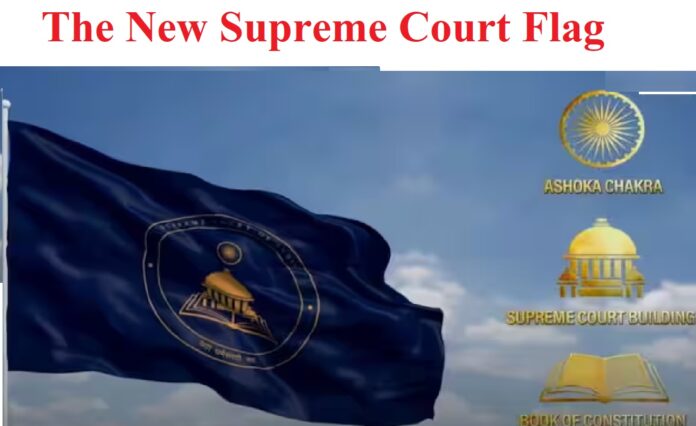(NTI): The Supreme Court of India introduced its official flag, a symbol rich in historical significance and meaning. This flag was first unveiled at the National Conference of the District Judiciary, held on August 31 and September 1, 2024. The conference, hosted at Bharat Mandapam, was inaugurated by Prime Minister Narendra Modi, who also released a commemorative coin and postage stamp marking the Supreme Court’s 75th anniversary. Chief Justice of India DY Chandrachud and other dignitaries were also in attendance.
Design and Symbolism of the Flag
President Droupadi Murmu unveiled the flag, which is navy blue in color and features key symbols: the Ashoka Chakra, the building of the Supreme Court, and the Constitution of India. The flag bears the inscription “Supreme Court of India” along with the Sanskrit phrase “Yato Dharmastato Jayah,” which means “Where there is Dharma, there is victory.” The design was conceptualized by the National Institute of Fashion Technology, New Delhi, with each element carrying deep symbolic meaning.
Decoding “Yato Dharmastato Jayah”
The phrase “Yato Dharmastato Jayah,” inscribed in Devanagari script, originates from the Indian epic ‘Mahabharata’ and translates to “Where there is Dharma, there is victory.” In Indian tradition, Dharma encompasses more than religion—it signifies law, justice, and duty. Ancient texts like the ‘Dharmashastra’ offer guidance on law, morality, and duty, underscoring the integral role of Dharma in Indian society. In the context of the Supreme Court, this phrase underscores the principle that where there is the rule of law, victory follows. The rule of law, a cornerstone of Indian democracy, was adopted from the British legal system during the drafting of the Indian Constitution.
The Principle of Rule of Law
The concept of the rule of law was articulated by British constitutional theorist Albert Venn Dicey in his 1885 book, “The Law of the Constitution.” This principle asserts that the law is supreme and applies equally to all, ensuring that everyone, including the legislature, administration, and judiciary, adheres to it. The independent judiciary, particularly the Supreme Court, is the guardian of the Indian Constitution, ensuring that any legislative or executive actions that violate the Constitution can be challenged directly in the Supreme Court.
On the flag, the Supreme Court building is depicted atop the Indian Constitution, symbolizing the Court’s critical role in upholding justice in accordance with the Constitution.
The Ashoka Chakra: A Symbol of Dharma
The Ashoka Chakra, featured on the flag, is borrowed from the Indian national flag, where it is known as the “Wheel of Dharma.” Dr. B.R. Ambedkar advocated for the inclusion of the Ashoka Chakra in place of the spinning wheel on the national flag, recognizing its deep historical significance. The Chakra is navy blue, a color echoed in the Supreme Court flag, symbolizing the wheel of law.
The Ashoka Chakra honors Emperor Ashoka, a warrior who embraced Buddhism and non-violence. It is modeled after the ‘wheel of dharma,’ a symbol prevalent in Hinduism, Jainism, and Buddhism. In Buddhist tradition, the Buddha is believed to have set the “wheel of dharma” in motion with his first sermon, symbolizing a transformative change with universal impact.
The spokes of the Ashoka Chakra represent various values, including chastity, morality, peace, sacrifice, justice, welfare, service, forgiveness, duties, and rights, all of which are essential to India’s progress.
A Flag of Constitutional Guardianship
Together, the Ashoka Chakra, the Supreme Court building, the Indian Constitution, and the phrase “Yato Dharmastato Jayah” on the new flag symbolize the Supreme Court’s role as the protector of the Indian Constitution and the enforcer of the rule of law in the country.


